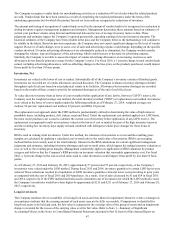Albertsons 2016 Annual Report Download - page 48
Download and view the complete annual report
Please find page 48 of the 2016 Albertsons annual report below. You can navigate through the pages in the report by either clicking on the pages listed below, or by using the keyword search tool below to find specific information within the annual report.46
Pension and Other Postretirement Benefit Obligations
Cash contributions to defined benefit pension and other postretirement benefit plans were $40, $169 and $124 in fiscal 2016,
2015 and 2014, respectively, in accordance with the Employee Retirement Income Security Act of 1974, as amended
(“ERISA”), minimum requirements along with certain discretionary contributions made by the Company. Cash contributions
decreased in fiscal 2016 due to lower required and discretionary defined benefit pension plan contributions. Cash contributions
increased in fiscal 2015 primarily due to a $50 discretionary contribution made in fiscal 2015 that helped to offset the decrease
in the funded status of the SUPERVALU Retirement Plan resulting from the plan’s assets and liabilities being re-measured at
November 29, 2014.
The Company anticipates fiscal 2017 contributions to pension and other postretirement benefit plans will be approximately $30
to $35, which primarily reflect discretionary defined benefit pension contributions and required minimum other postretirement
benefit plan contributions. The Company currently expects that no minimum pension contributions will be required to the
Company's pension plans in fiscal 2017.
In August 2014, the Highway and Transportation Funding Act of 2014, which included an extension of pension funding interest
rate relief, was signed into law. The Highway and Transportation Funding Act includes a provision for interest rate stabilization
for defined benefit employee pension plans. As a result of this stabilization provision, the Company expects to not be required
to make pension contributions to the SUPERVALU INC. Retirement Plan in fiscal 2017.
The Company funds its defined benefit pension plans based on the minimum contribution amount required under ERISA, the
Pension Protection Act of 2006 and other applicable laws, as determined by the Company’s external actuarial consultant, and
additional contributions made at the Company's discretion. The Company may accelerate contributions or undertake
contributions in excess of the minimum requirements from time to time subject to the availability of cash in excess of operating
and financing needs or other factors as may be applicable. The Company assesses the relative attractiveness of the use of cash
to accelerate contributions considering such factors as expected return on assets, discount rates, cost of debt, reducing or
eliminating required PBGC variable rate premiums or in order to achieve exemption from participant notices of underfunding.
During the third quarter of fiscal 2015, the Company made lump sum settlement payments to certain deferred vested pension
plan participants under a lump sum payment option window. The payments were equal to the present value of the participants'
pension benefits, and were made to certain former employees who were deferred vested participants in the SUPERVALU
Retirement Plan, who had not yet begun receiving monthly pension benefit payments and who elected to participate in the lump
sum payment option window. In fiscal 2015, the SUPERVALU Retirement Plan made lump sum settlement payments of
approximately $272. The lump sum settlement payments resulted in a non-cash pension settlement charge of $64 from the
acceleration of a portion of the accumulated unrecognized actuarial loss.
CRITICAL ACCOUNTING POLICIES
The preparation of Consolidated Financial Statements in conformity with accounting principles generally accepted in the
United States of America (“Accounting Standards”) requires management to make estimates and assumptions that affect the
reported amounts of assets and liabilities and disclosure of contingent assets and liabilities as of the date of the financial
statements and the reported amounts of revenues and expenses during the reporting period. Actual results could differ from
those estimates.
Significant accounting policies are discussed in Note 1—Summary of Significant Accounting Policies in the Notes to
Consolidated Financial Statements included in Part II, Item 8 of this Annual Report on Form 10-K. Management believes the
following critical accounting policies reflect its more subjective or complex judgments and estimates used in the preparation of
the Company’s Consolidated Financial Statements.
Vendor Funds
The Company receives funds from many of the vendors whose products the Company buys for resale in its stores. These
vendor funds are provided to increase the sell-through of the related products. The Company receives vendor funds for a variety
of merchandising activities: placement of the vendors’ products in the Company’s advertising; display of the vendors’ products
in prominent locations in the Company’s stores; supporting the introduction of new products into the Company’s retail stores
and distribution system; exclusivity rights in certain categories; and to compensate for temporary price reductions offered to
customers on products held for sale at retail stores. The Company also receives vendor funds for buying activities such as
volume commitment rebates, credits for purchasing products in advance of their need and cash discounts for the early payment
of merchandise purchases. The majority of the vendor fund contracts have terms of less than a year, with a small proportion of
the contracts longer than one year.
























